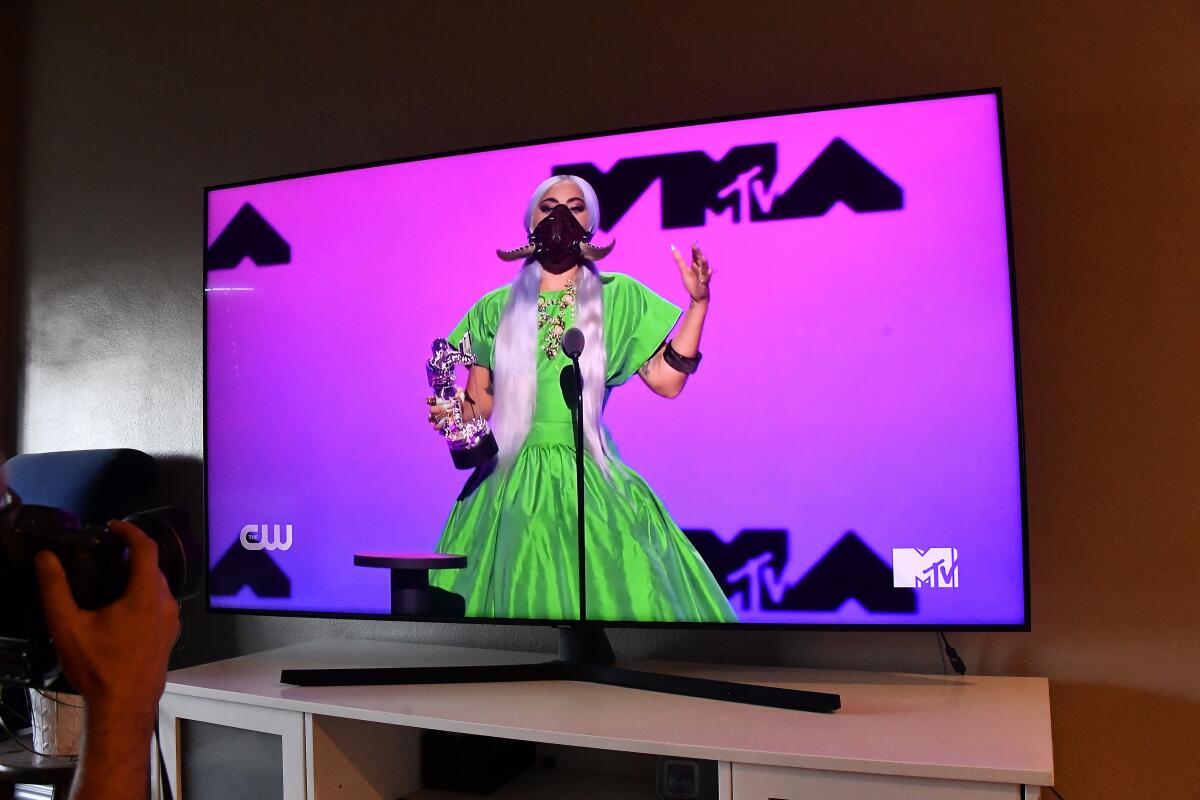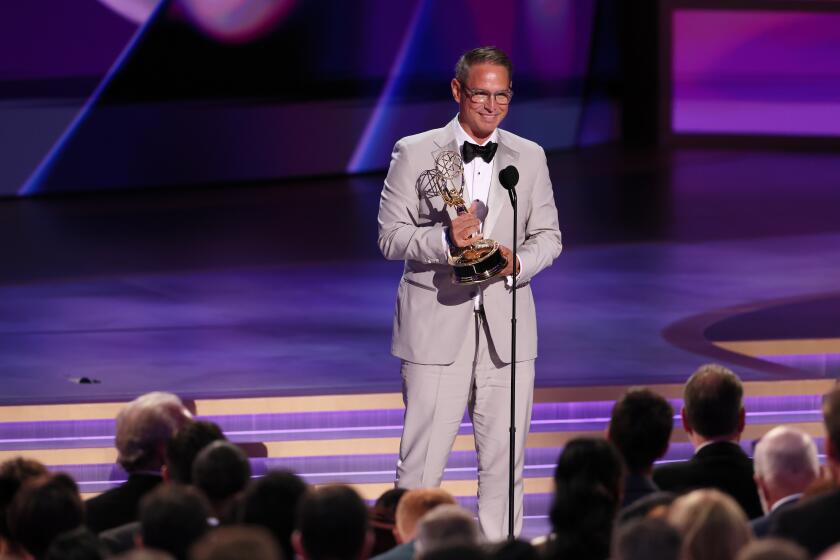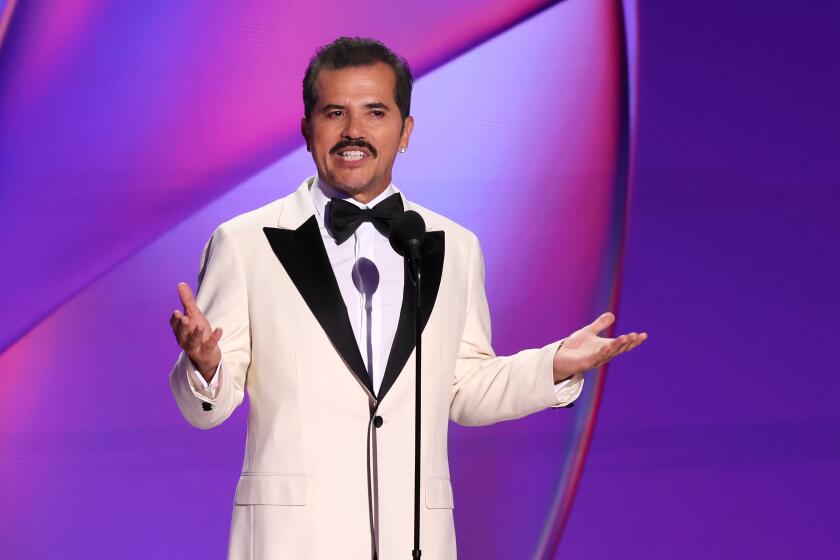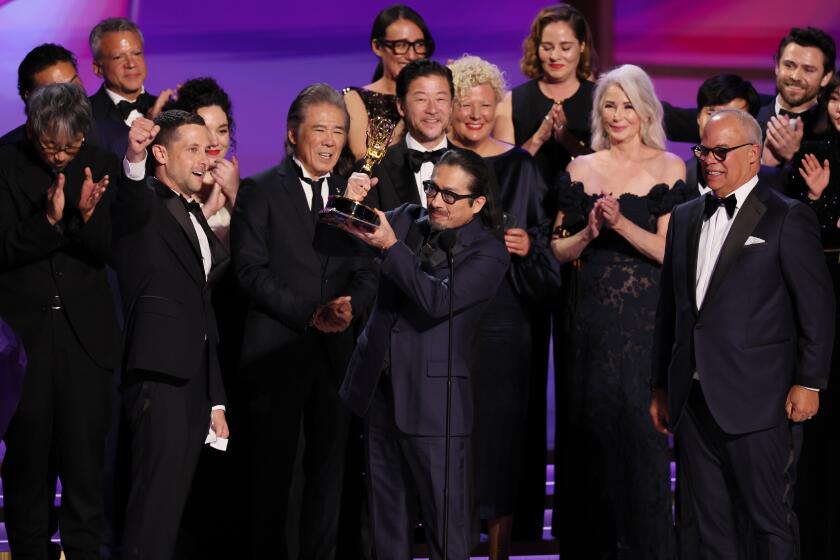Commentary: 5 lessons the VMAs can teach the 2020 Emmys about COVID-era award shows

When it comes to awards shows, MTV’s Video Music Awards (better known as the VMAs) is a species unto itself. Its closest kin is the Grammys: performance-dominated and characterized by wildly imaginative production design and flights of fancy that very much extend to the stars’ attire.
The Emmys, on the other hand, are more in the Oscars’ immediate family of formal, black-tie affairs. For instance, they’re not likely to pick up on the VMAs’ celebration of well-lit crotches.
Details are still emerging about how producers plan to adapt the Television Academy’s biggest night to the pandemic for its Sept. 20 Emmy broadcast, hosted by Jimmy Kimmel from the reportedly audience-free, red-carpet-free Staples Center. But the recent remote Democratic National Convention isn’t the only possible model. What could the Emmys learn from MTV? Here are five possible answers:

Doja Cat performs “Say So” & “Like That” at the 2020 VMAs.
Think big
Sunday’s VMAs showed just how far green-screen technology has come for televised performances. The virtual environments shifted at the drop of a beat, going from a mermaid’s dreamy grotto to something like the inside of a graphic equalizer — and did it seamlessly. And that was just for the performances that apparently took place on the stage; the VFX were so effective, it was hard to tell what, if anything, was live. K-Pop kings BTS, beaming in from South Korea, performed in several virtual New York panoramas. Mexican boy band CNCO interacted with the actual cars on one set’s drive-in setup. The Emmys may not be as performance-dependent or aesthetically audacious, but the MTV production certainly kicked open possibilities that could make the TV Academy show visually compelling.
At MTV’s 35th VMAs, the Lady Gaga and Ariana Grande duet “Rain on Me” won song of the year and best collaboration, while Gaga also took home the prize for artist of the year. The Weeknd nabbed the night’s biggest award, video of the year, for “Blinding Lights,” and best direction went to first-time director Taylor Swift for her song “The Man.”Hosted by Keke Palmer, the event featured performances by Lady Gaga and Ariana Grande, Da Baby, Miley Cyrus, BTS, Doja Cat, Latin boy band CNCO and Maluma. Gaga and Grande led the field with nine nominations apiece, followed by The Weeknd and Billie Eilish with six.
It’s all about location, location, location
Since virtual awards shows aren’t anchored to a single venue where the big stars are sitting for several hours, they don’t have to be limited by location at all. The Weeknd opened the show with a startlingly effective presentation of his hit “Blinding Lights” atop a skyscraper (an actual one, not a virtual one), capped off by fireworks shot from boats on the river below. The Emmy takeaway from this should be that not only performances, but skits and even presenters, could be anywhere.

The Weeknd kicks off the 2020 VMAs with a spectacular rendition of “Blinding Lights.”
Skip the canned crowd noise
To be fair, it might be strange to see someone receive an acting trophy without any cheers. But while pro sports have found comfort in piping in crowd noise and filling the stands with cutouts of fans, even dead ones, the VMAs’ apparently fake crowd reactions, including “laughs” responding to jokes, made the affair feel a bit like a multi-camera sitcom and not in the throwback, ironic way. One possible solution: a wall of screens showing live humans on video, reacting to the awards as supporters did to the candidates at the DNC? Or perhaps having several venues with audiences, all socially distanced, with live audio?
Five seasoned entertainment journalists predict the shows and performances the Television Academy will honor with Emmys; do you agree with their picks?
Don’t forget the other nominees
The VMAs telecast chose not to show the nominees as their names were announced. Instead, the moment the winners were announced, they strolled before the camera or videos of their speeches popped up. This gave the strong impression that winners knew in advance, which may have been deemed a necessity by the production but removes the moment of drama that defines awards season: those fleeting seconds of anticipation on the nominees’ faces, followed by the winner’s real-time reaction. One would expect the more-traditional Emmys to stick with trying to televise that moment live, despite the logistical problems it surely creates. At an in-person venue, this might mean a separate holding area for each nominee in a category, complete with camera setup, to adhere to social distancing. (Those not in attendance could appear via video conference.) It’s the element of surprise that comes with the winning (or losing) moment that the VMAs missed entirely.

Even at the virtual event, you can’t ignore the real world
Presenters and performers at the VMAs didn’t shrink from referring to the ongoing protests against racial injustice or the altered reality of the pandemic; they featured them.
At the top of the show, host Keke Palmer addressed Black Lives Matter; The Weeknd, in collecting his two trophies of the night, said both times it was difficult for him to celebrate, calling instead for justice for Jacob Blake and Breonna Taylor. Lady Gaga put her costumers to work on designing extravagant masks, and backup dancers performed masked as well. DaBaby incorporated references to both PPE and the police into his act. Presenter Anthony Ramos (of “Hamilton”) donned a mask emblazoned with the word “VOTE.” The effect was not one of beating the audience over the head with political messages but of acknowledging the 800-pound gorillas in the room and, in Gaga’s case, dancing with them.
The Emmys would do well to follow suit and embrace topical statements during the ceremony. It would be a welcome human touch in an era of enforced distance.
More to Read
The complete guide to home viewing
Get Screen Gab for everything about the TV shows and streaming movies everyone’s talking about.
You may occasionally receive promotional content from the Los Angeles Times.








